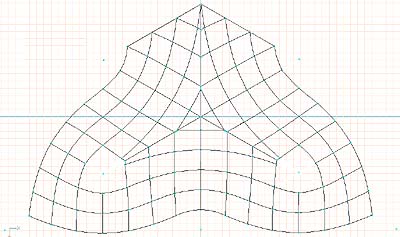 |
PAGE 2
|
| HOME | Contact | Ridge Conic | Why Conics | Participate |
|---|
 |
The entire conic was constructed of 4'x4' panels of 1/2" CDX 5 ply plywood. The diagram at left shows the basic layout of these panels. Some panels along the parabolic arch are specially cut to conform to the curve that connects the 4 peaks of the conic. There are a total of 111 individual pieces of plywood and 22 different patterns composing the conic. The top most openings were covered with inexpensive fiberglass sheeting. This created a skylight where the curve was too great for the plywood to bend. |
 |
The "generator poles" form the tripod structure to which the conic plywood panels attach. These were constructed of 4x14 Douglas Fir and were ripped with a beam saw so that each board created two tapered generator poles 2" thick at one end and 12" thick at the other. This is structurally important as well as visually pleasing because the lower portions of the generator poles take more weight and stress. The generator poles where hoisted up with the use of a "jin" pole (a pole with a winch attached at the bottom and a pully at the top... sort of a poor man's crane). |
 |
The top of the generators were attached with three metal brackets. A common hole at the top of each bracket was held together with a 3' continuous threaded rod that exented above the tripod about 28 inches. We used these rods a tie-off points for climbing ropes and they served double-duty as flag poles. |
 |
The desert playa was a marvelously flat and plyable surface. Divits in the playa surface held the base of each generator temporarially. Anchor screws were then drilled into the playa to a depth of about 18 inches. About 12" below the surface the playa becomes a thick gooey mud that readily held the base of the anchor screws. To keep the base of the generator poles snug to one another Richie Wasserman used a continuaously threaded 5/8" bolt that carefully runs through the 120 degree spread of the two adjacent generators. |